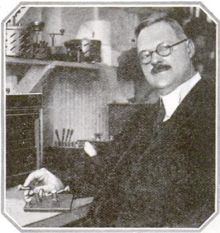Greenleaf Whittier Pickard | |
|---|---|
 Radio pioneer G.W. Pickard in his Boston laboratory | |
| Born | (1877-02-14)February 14, 1877 |
| Died | January 8, 1956(1956-01-08) (aged 78) |
| Nationality | American |
| Awards | IEEE Medal of Honor (1926) |
| Scientific career | |
| Fields | Electrical engineering |
Greenleaf Whittier Pickard (February 14, 1877, Portland, Maine – January 8, 1956, Newton, Massachusetts) was a United States radio researcher in the early days of wireless.
While not the earliest discoverer of the rectifying properties of contact between certain solid materials, he was largely responsible and most famous for the development of the crystal detector, the earliest type of diode detector. The crystal detector was the central component in many early radio receivers from around 1906 until about 1920. Pickard also experimented with antennas, radio wave propagation and noise suppression.
On August 30, 1906 he filed a patent for a silicon crystal detector, which was granted on November 20, 1906.
On June 10, 1907 he filed a patent for a "Magnetic Aerial" (a loop aerial) which was granted on January 21, 1908. Pickard's loop antenna had directional properties that could be used to reduce interference to the intended wireless communications.
On June 21, 1911 he filed a patent on a crystal detector incorporating a springy low inertia wire of about 24 gauge formed with a loop or helix and pointed to make contact with the crystal. Crystal detectors incorporating this construction would become the most widely used and popularly known by the term cat whisker detector. This patent was granted on July 21, 1914.
Greenleaf Whittier Pickard was named after his great-uncle, the American Quaker John Greenleaf Whittier (1807-1892). Pickard was president of the Institute of Radio Engineers in 1913.